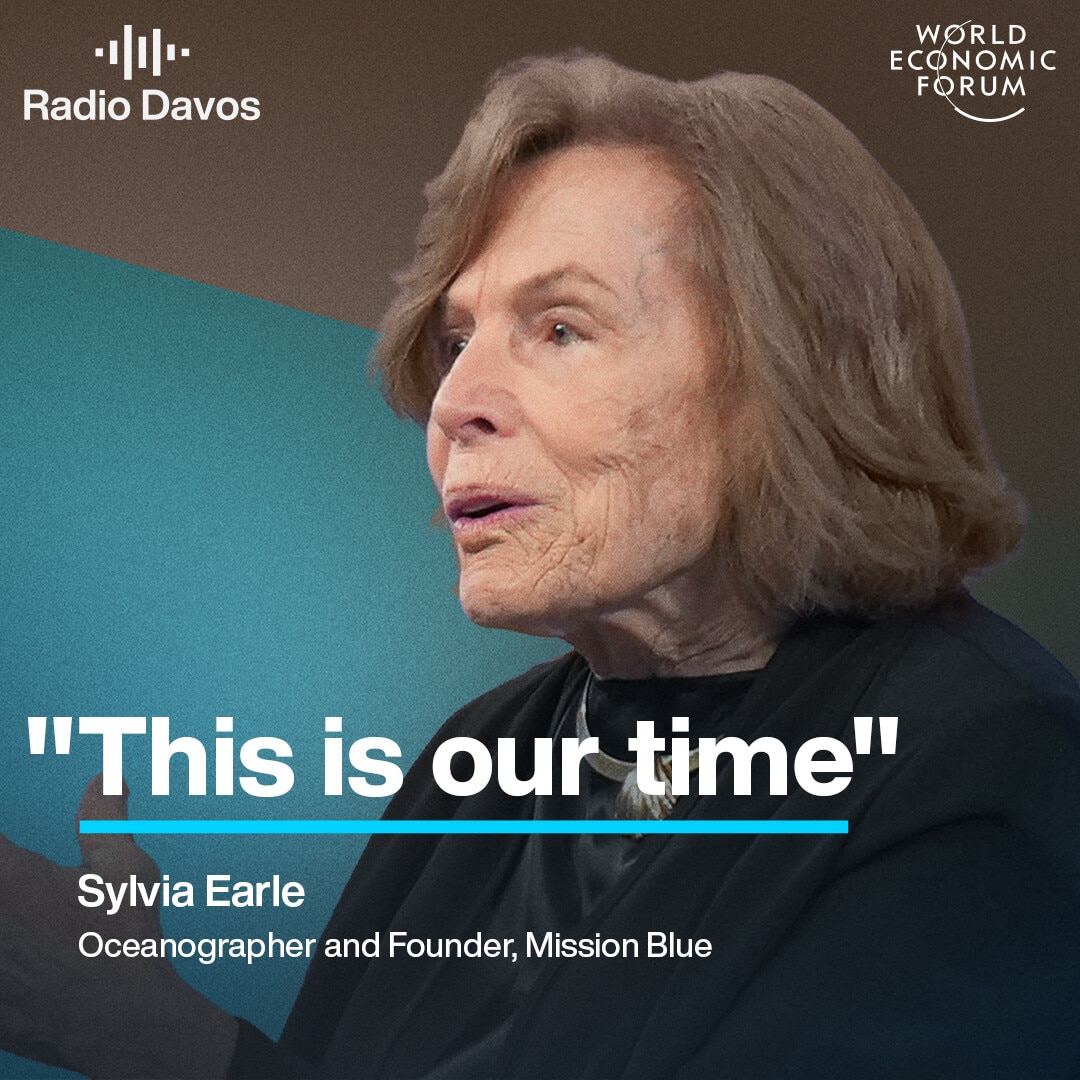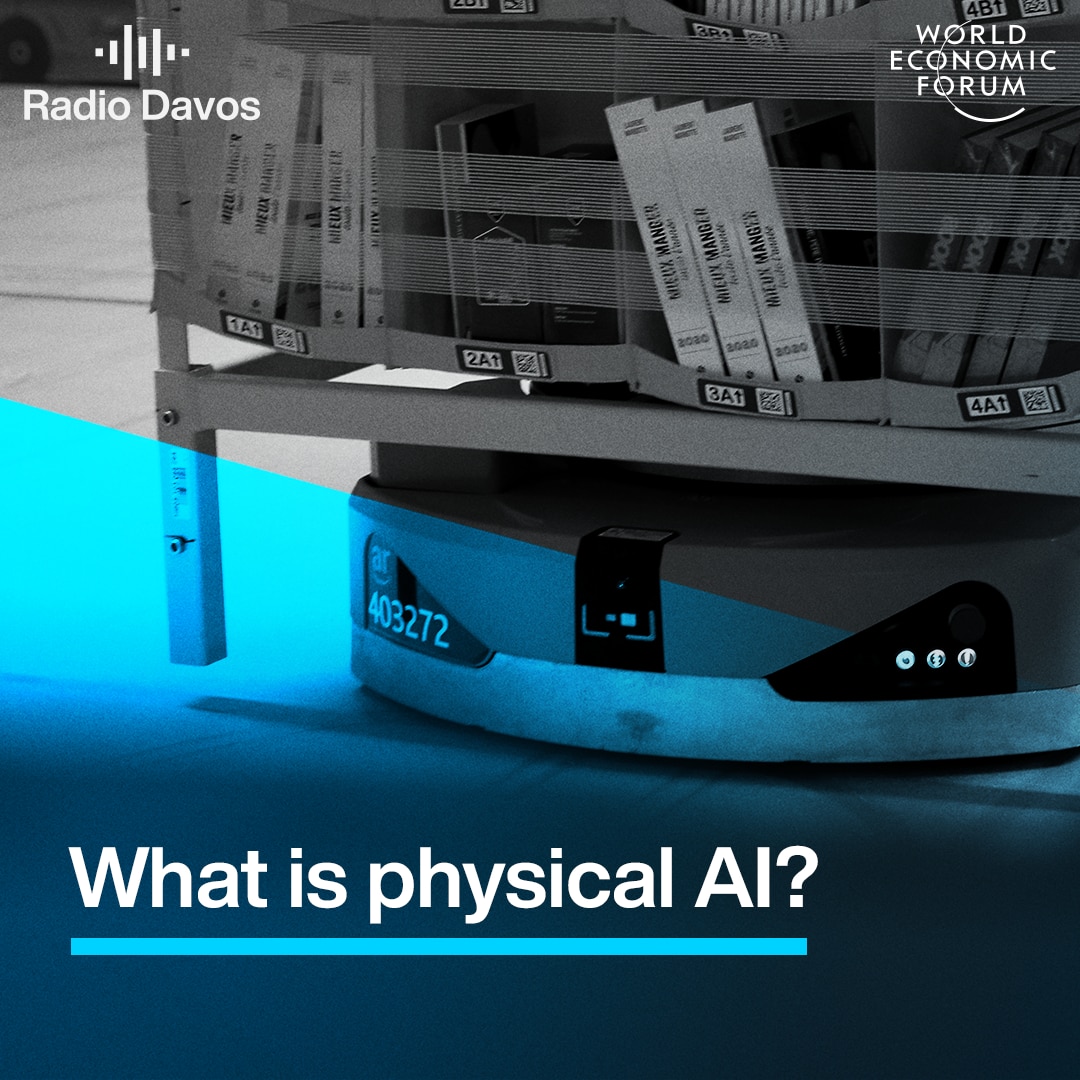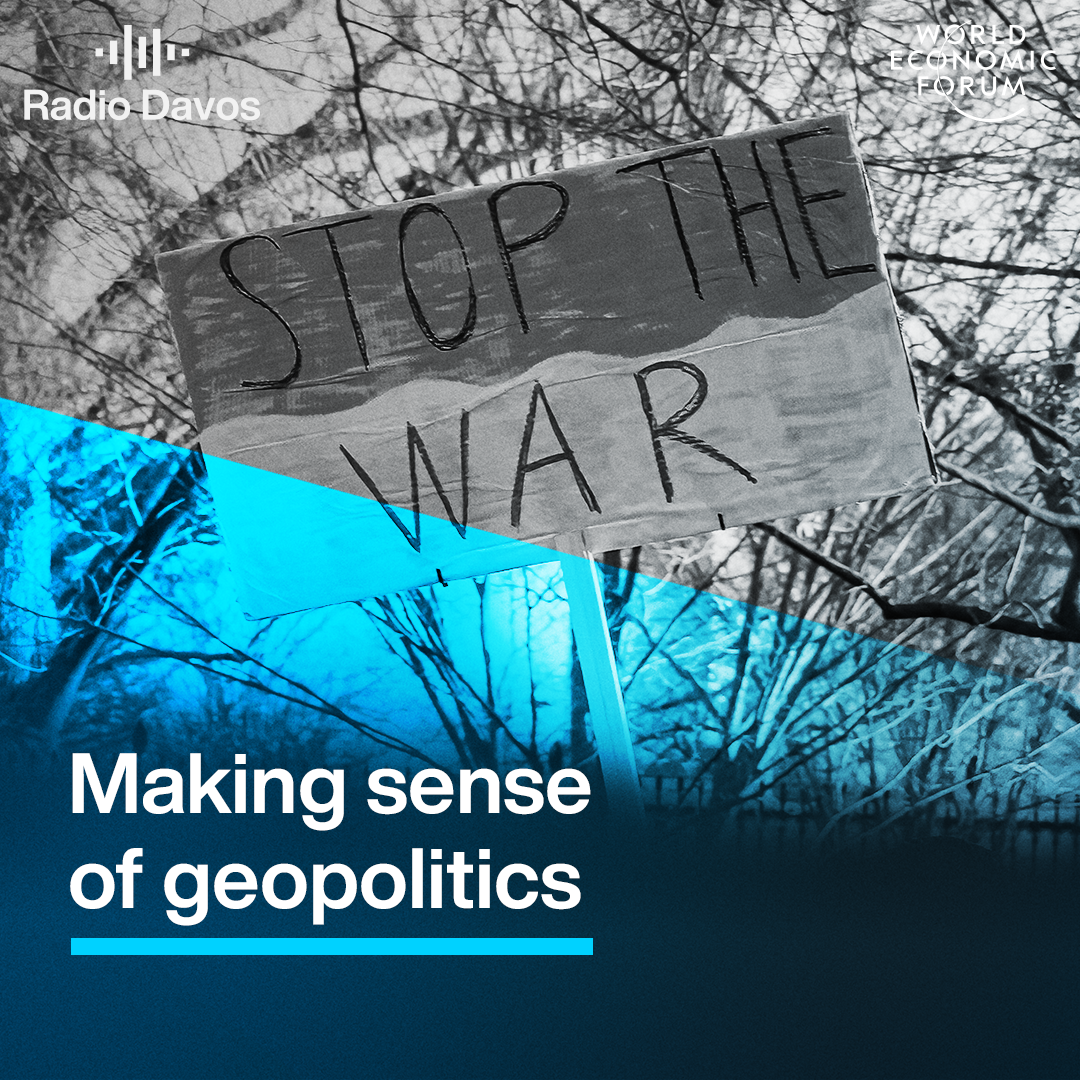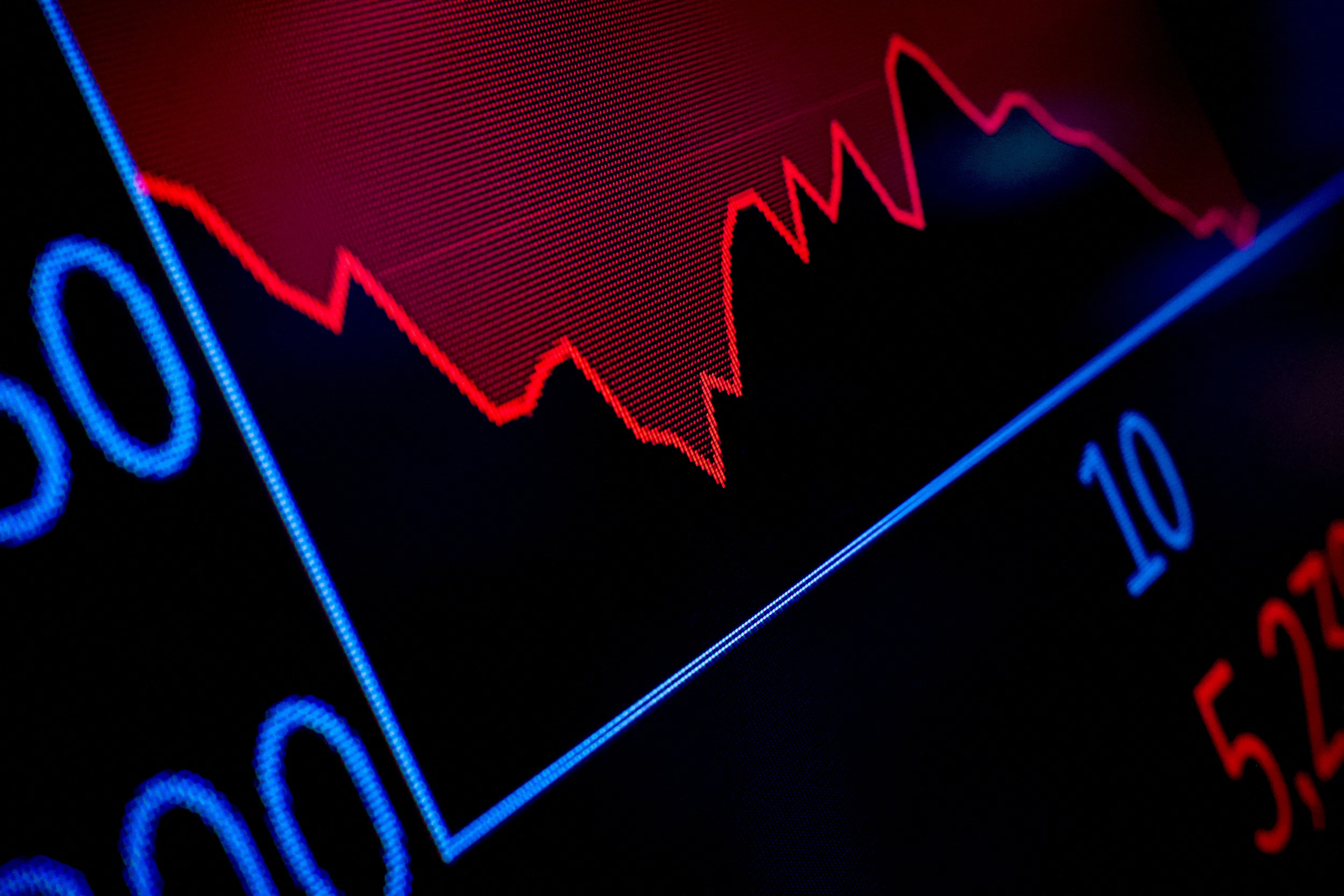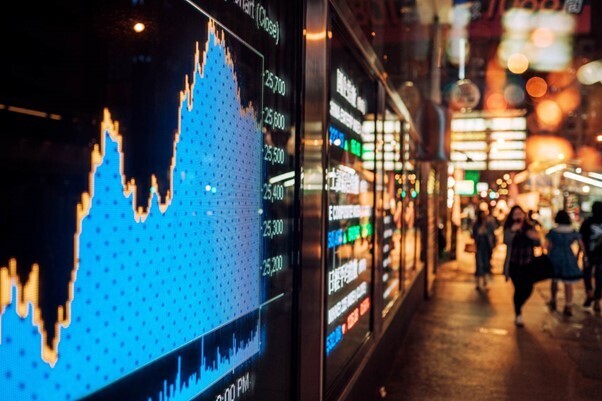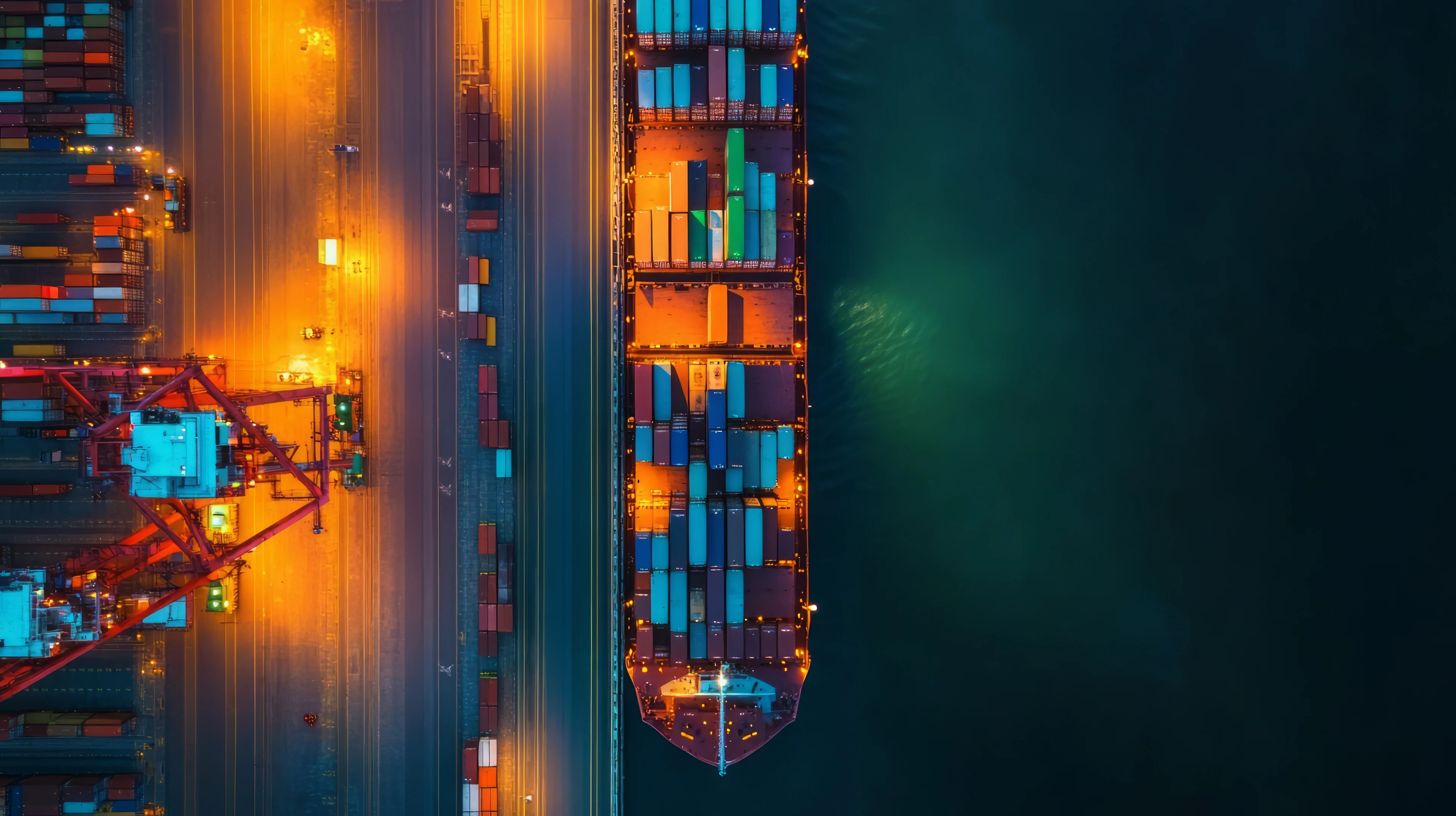What are 'embedded emissions' and can global trade help reduce them?
播客文字稿
Aaron Cosbey, Senior Associate, International Institute for Sustainable Development (IISD): The most recent innovation is a price on imported carbon so we've seen the EU put forward its Carbon Border Adjustment Nechanism, which forces importers to buy carbon allowances as if they had been producing under the EU domestic regime.
Robin Pomeroy, host, Radio Davos: Welcome to Radio Davos, the podcast from the World Economic Forum. This week, the greenhouse gasses emitted in the production of goods traded around the world.
Aaron Cosbey: The idea basically is, you know, if you're doing this to your domestic producers, if you're putting a price on their carbon, you don't want your efforts to be undercut by imports from countries that aren't doing that. You start to price the embedded carbon in goods as they come into your border.
Kimberley Botwright, Head, Sustainable Trade, World Economic Forum: About 23% of all global emissions are moved about through trade Asia. What is the reaction to some of the export markets pricing in carbon?
Dandy Rafitrandi, researcher at the Department of Economics, Centre for Strategic and International Studies (CSIS), Indonesia: Several countries, including the UK, Australia, Japan, Canada, are starting to discuss some CBM-like policy. That's what makes developing countries a bit worried.
Sustainable trade is the future of trade.
Robin Pomeroy: I'm joined here in the studio by a co-host, Kimberly Botwright, deputy head of the Centre for Regions, Trade and Geopolitics at the World Economic Forum. Hi, Kimberly. How are you?
Kimberley Botwright: I'm well, thank you.
Robin Pomeroy: Very well, thank you. You suggested to me, after I did another Radio Davos episode about trade, that we should look into this issue. And I'm really, really interested to find out what it's all about. Well, I mean, what are embedded emissions, which is what we're talking about today?
Kimberley Botwright: Exactly. So embedded emissions, we often use that as a shorthand, but what we're saying is, as you just outlined, emissions in trade.
When we look at measuring countries' emissions, we could talk about measuring what they produce that contributes to emissions in the global economy, or we could about what they consume.
And mostly under the UNFCCC framework, we are focusing on the emissions that countries produce, but actually some of countries' emissions are actually imported and are then consumption-based emissions. And that's actually about 23% of all global emissions come or are moved about through trade.
So we're not talking about the emissions that come from boats and shipping of moving the goods around, but literally the demand in one country for a product is met by emissions being produced in another country and then imported into.
Robin Pomeroy: I'll just jargon bust there, UNFCCC is?
Kimberley Botwright: The UN Framework Convention on Climate Change, which is the mother of the Paris Agreement.
Robin Pomeroy: Right, and how we measure emissions is, if anyone's not kind of looked into this, it's not always as you might expect. There is some satellite data, but very often it's measured by the amount of energy that goes into, so the amount of coal that's burnt or gas that's burned. And that's probably why, I'm guessing, it's the producer countries that originally were measuring that.
Kimberley Botwright: Yeah, aggregate. I mean, most of the way that we've looked at measuring emissions has been done on a production level for countries. And so when you start to look at measuring emissions in trade, you have to look the trade between countries, the input-output tables and then map that onto the emissions that probably went into the production and where it then ended up. So it's quite a tricky business and there's a few different ways of doing it. And there's few different databases that are out there. We've got a blog online that covers this in great detail.
Robin Pomeroy: Link in the show notes, no doubt. Okay, we've got two experts online. Could you tell us who they are?
Kimberley Botwright: We do indeed have two excellent experts.
So first we have, we're joined by Aaron Cosbey, who's a senior associate for the International Institute for Sustainable Development, IISD. Aaron is a development economist with 30 years of experience around trade investment and sustainable development. He's also advises various government and nonprofit entities.
And then we have Dandy Rafitrandi, who's a researcher in the Department of Economics for CSIS Indonesia. Dandy is actually the editor-in-chief, so shares a passion for editing like you, Robin, for the CSIS editorial team, and is the project director of the Decarbonization for Development DfD Lab. And he has a very rich academic background in trade and sustainability.
So I couldn't think of two better experts to help us unpack embedded emissions and the implications for trade.
Robin Pomeroy: Thanks very much, Kimberly. Hi to you both. Let me start with Aaron. Aaron, give us a brief history of how we've tried to price emissions and how we try to price imported emissions.
Aaron Cosbey: Well, you can blame it all on the economists. An economist named Arthur Pigou back in the 20s suggested that you would want to put a tax on things that you don't want to cover the costs that aren't actually embedded in the actual cost.
And then late in the twentieth century, more environmental economists came up with the idea of putting a price on carbon as a way to deal with the unpriced damage that GHG emissions were doing to the environment.
So you had, Finland introduced the first carbon tax way back in 1990. 23 other EU countries followed with a carbon tax thereafter.
And then you had this innovation where the U.S. introduced an acid rain reduction program that was a cap and trade scheme. So they put a cap on the amount of pollution they wanted to see and they allowed the emitters that were regulated under that cap to trade amongst themselves so that those that had an easier time doing emissions reductions could do more and then trade them to those that had a harder time.
So that was an evolution from a carbon tax to a cap and trade scheme. We now have both kinds of schemes operating in the world. There's more than 70 jurisdictions nationally that have some kind of carbon pricing, either a carbon tax or a cap-and-trade scheme, and you've got a wide range from like a dollar ton to over a hundred dollars a ton.
They cover everything from basic fuel levies on things like gasoline and coal and natural gas to taxes on industrial emitters, the big heavy industrial emiters.
In the last years you've seen some pushback on affordability in the context of you know soaring oil and gas prices and food costs but for the most part these are maintaining strong and going strong.
The most recent innovation as you suggested is a price on imported carbon so we've seen the EU put forward its Carbon Border Adjustment Nechanism, which forces importers to buy carbon allowances as if they had been producing under the EU domestic regime.
So this is really an innovation that has taken off. We've seen the UK also announce its intention to put in place a CBAM and Norway and other countries also considering. And the idea basically is, you know, if you're doing this to your domestic producers, if you're putting a price on their carbon, you don't want your efforts to be undercut by imports from countries that aren't doing that. So you start to price the embedded carbon in goods as they come into your border.
Kimberley Botwright: So, indeed we're seeing that from the EU and potentially Canada and a few others, but Dandy, over in your part of the world, manufacturing, well, ASEAN and Asia is the manufacturing hub of the word, and so producing some emissions as part of that, what's the thinking around carbon pricing and then also subsequently, what is the reaction to some of the export markets pricing in carbon that will affect those exports?
Dandy Rafitrandi: Yeah, thanks Kimberly. I think in terms of developing countries, we have a bit of different views in a way that we are more cautiously embracing carbon pricing.
But I think the big question here is that we still have to balance between development, economic growth, but also embracing the climate adaptation.
And I think this is the perspective that developing countries right now is really thinking through whether this is about carbon pricing, carbon tax, and I think in ASEAN, especially in Indonesia, we are in a pretty nascent stage of development in terms of carbon pricing, but, for example, in Indonesia, as Aaron mentioned, carbon border adjustment mechanism. And I think it's also one of the concerns by the developing countries. But it's sort of like a force towards having a more robust carbon pricing, carbon tax, and a market system that is actually really price the carbon right and I think that's all these CBAMs for.
Robin Pomeroy: If I understand it correctly, a country exporting goods to the European Union or a company exporting goods to European Union, those goods will either face a levy imposed to compensate for those emissions, or if that country has its own limits on greenhouse gas emissions that are equivalent to the European Union's, that levy would not be imposed, is that how it works?
Kimberley Botwright: Roughly, Aaron, you're a bit more of a technical expert, I think, on CBAM. That basically sums it up, but there are some complexities to take into consideration.
Aaron Cosbey: Sure. To start, let's be clear, we're talking about a small range of goods that are considered energy intensive trade exposed.
These are the ones that are high emitting, but also highly traded. This is steel, cement, aluminum, fertilizers, nitrogenous fertilizers, hydrogen, in the case of the European Union. And for these goods, yes, they have to buy allowances at the border when they enter the EU.
But there's a provision in the CBAM that if a carbon price was effectively paid in the country of export, and we'll get to what effectively paid means in just a second, that can be credited against the charge at the border. So it's not an exemption. You don't get eliminated from coverage of the CBAM if you have a carbon place at home, but you get a credit for the amount you paid in a carbon-price back home.
What price effectively paid mean is a good question because every carbon pricing scheme in the world has provisions which allow for the use of offsets, which means you didn't do the emissions reductions yourself, but you bought them from someone else, or tax exemptions or free allocation of emission allowances to really high risk leakage firms.
So it's a calculation what the effective carbon price would be. But the principle is yes, if you do that, have carbon pricing at home, you get a credit. And that's an attractive option for many countries because if you're the government your option is allow your firms to pay money to the European Union, or put in place your own domestic price and keep those revenues at home and use them for a number of beneficial, development-oriented probably, and decarbonization type objectives.
Robin Pomeroy: How has this been received then globally? Dandy's in Indonesia, and I know this kind of thing was talked about many, many years before it actually came to pass, and it was often said to be kind of impossible because of world trade rules, that if you had a chunk of steel, the same as a chunk of steel produced here with various laws about emissions, a chunk of steel produced there without those laws, but it's effectively the same product, that you could not put in place these kinds of trade barriers.
Also, there's often a tension between something put in place, perhaps, to protect the environment, or animal welfare type things that another country would say, you're doing that to prevent our imports or to make our imports more expensive.
How has that, has everyone now accepted the CBAM is a legitimate thing and we're all going to play ball? Or is it still, both of you are, you have rueful expressions on your faces. Tell us something about how it's seen and where you see things going.
Dandy Rafitrandi: Sure, maybe I can start from the perspective of developing countries.
There's a pretty big concern about the competitiveness impact towards export products for developing countries, I think the World Bank has released like a database how big actually the exposure of the CBAM towards countries in the world and some of the biggest hit, that's actually developing countries.
So that's the first one. So this is really a question about whether CBAM is going to impact the competitiveness of developing countries export products.
The second one is knowing that obviously many industries in developing countries still rely on fossil fuel export and of course they have to pay very high in terms of you know carbon price in a way that it's still a very high energy intensive manufacturing right. So and then I think there's also concern about of course if steel and cement price for export will be higher.
What we fear is that there is a spillover towards other industries as well in domestic and developing countries. So we don't want this channel actually go disproportionately burdening the lower income populations.
So there is this, you know, concern about inflation because of due to this. CBAM, for example, and I think because of, you know, the basic industries like steel and cement, they have a very, very long value chain domestically. So I think if the price is increasing, then all of the industries will actually get an impact.
Robin Pomeroy: Aaron, do you have a view on how it's being seen? You've been working on this issue for a long time.
Aaron Cosbey: Well, as Dandy said, the exporters and particularly exporters in developing countries aren't particularly happy about this kind of a measure, but it's different from country to country. The reality is different from county to country.
So if you look at a country like India where steel is produced primarily using highly polluting blast furnace, basic oxygen furnace methods, it's a disaster for the Indian steel exporters to put a price on their carbon, price on the embedded carbon in their steel.
If you look by contrast at China where you know it's a big steel market and on a national average basis it's also produced rather durably but because it's such a big market you have a small production percentage that's clean produced with renewable energy and with electric arc furnaces. You know, that small percentage is big enough to fill the entire export flow from existing export flow from China to the EU and those, you know, so you'll get this reorientation of trade flows to the advantage of China as an exporter of steel because it will compete favorably with EU steel on the domestic market in the EU.
So every country has a different situation.
I think that the big reaction from a lot of developing countries is a protest of injustice. The idea is, look, You've created this problem, you being developing countries have created this problem and now you're trying to deal with it and you're saddling us with the costs of you dealing with it.
You can come down on both sides of this question. You can say the EU's just taking leadership and that's necessary and you know, all they're doing is leveling the playing field or you can see it as an injustice. But the general reaction has been one of protest against the thing.
And in terms of legal, yes, It's probably illegal, according to the basic rules, non-discrimination principles of the general agreement on trading tariffs, if you want to get weedy about it. But there are environmental exceptions in that agreement that the EU and other countries interested in CBAM are arguing will probably save their measures from being ruled ultimately illegal under World Trade Organization rules.
Robin Pomeroy: I mean, will it have an impact of kind of nudging countries to adopt those technologies, which are still some of them, electric arc furnaces to create steel. I mean even in a lot of developed countries, they're still in their infancy, aren't they, some of these technologies. But is that the hope? Are we seeing it already that this can encourage those countries to move away from those technologies?
I'm guessing if you've got a steelworks, the amount of money you've invested in that, the length of time it's got to live, you can't just suddenly switch it off and switch to something greener overnight, right?
Kimberley Botwright: I think Dandy made a great point that one of the key pieces here is the energy that's going into the manufacturing. And so I think if the extent to which a carbon tariff can help encourage international efforts and partnerships around decarbonizing the energy mix, particularly in these centres of production, it could be really interesting, because an electric arc furnace could actually be a lower emissions source of steel depending on the energy inputs.
But I think the challenge is actually getting that price signal passed along, as you pointed out, Robin, to the businesses that are actually then having to go to capital markets and borrow and justify and make that case and demonstrate that there's a clear ROI that's in the next foreseeable time horizon and not in 10 years.
Aaron, what are your thoughts on this?
Aaron Cosbey: There are two related kinds of impacts in other countries.
So the EU has said it's not about making other countries do anything, it's just about leveling the playing field for our domestic production.
But there are these two impacts on other countries and the first is you're seeing, and you alluded to this earlier, an increased interest in many countries, Dandy talked about this, in carbon pricing in-country, and precisely because they want to keep the revenues at home instead of giving them to the EU.
The CBAM itself is not really a reason enough to adopt carbon pricing in any country. It's a difficult thing to adopt politically, economically, it's costly on domestic industries. But a lot of countries have already been thinking about adopting carbon pricing. Some have been in the process of doing so. And the CBAM is one more nudge in the direction of those countries that adds to the arguments for carbon pricing, and it's been quite actually a remarkable effect.
You see carbon pricing adopted in Turkey, arguably in China, other countries, explicitly in reaction to the EU CBAM. So that's one thing.
The related effect, of course, is, as Kimberly said, those carbon prices adopted in other countries are going to result in cleaner production in those countries. As you raise the price of polluting forms of electricity generation, you start to get the substitution into better, cleaner forms of electric generation. And you may even see, ultimately, long-term investments in different production techniques, like switching from blast furnace to electric arc furnace, that's a more long- term prospect.
Those effects all become cascading effects as a result of this, but it depends really on your exposure to the markets that actually are doing this kind of import pricing. Many countries don't sell a whole lot to the EU. Some do. But the incentives are going to depend how exposed you are to markets that are doing this kind of import carbon pricing.
Robin Pomeroy: Dandy, how are you seeing the impacts?
Dandy Rafitrandi: I can share one of our research on the potential impact on CBAM towards Indonesia's economy.
I think, relatively, it's pretty small in a way that Indonesia not really exporting that big chunk of export products to the EU. However, we are afraid of, you know, the spillover towards this carbon border adjustment mechanism to other countries.
You know, we, I think several countries, including the UK, Australia, Japan, Canada, right now is actually starting to discuss whether they want to implement some CBAM-like policy.
And I think what makes developing countries, including Indonesia, a bit worried in a way that there is a lot of CBAM-like and they have different regulations, different rules. It means that higher cost of trade.
Kimberley Botwright: Dandy, have you seen any companies or any points of debate where people have said well actually if we have a low-carbon product we're now super competitive and should race to access and promote ourselves on the EU market?
Dandy Rafitrandi: Yeah, we have a couple of, for example, steel companies that actually see what we call the green premium as having this sort of like advantage of having a greener products.
I think the trend is there, but it's only very few companies that actually grasping towards that kind of opportunities.
And I think this is also our job in the CSIS to promote more and more sustainable trade and also adoption in terms of climate friendly energy. And I think this is also very important for our economy in the future.
Kimberley Botwright: And maybe Aaron, so it's not just about, you know, emerging economy and trade to the EU, but it covers Canada's trade to EU. And of course, those two big blocks have a trade deal with each other. So do you see any reflection on whether there's a way to position to be green competitive? And I know Canada has some challenge, perhaps, even in that space, because some of the products that they're exporting are quite carbon intensive.
Aaron Cosbey: Well, I mean, if you look at Canadian aluminum, it's much cleaner than EU aluminum as a national average. Canada is blessed with an abundance of hydropower and most of our electricity nationwide is produced from renewable sources. So our aluminum production is hooked up to that as such that it has very, very low emissions.
It will be competitive on the EU market vis-a-vis EU producers. So we're looking forward to that. And we also have a carbon price, so we'll get a credit for that.
Our steel is similarly less GHG-intense than EU steel, right? It doesn't, you know, it doesn't just matter how we compare to EU producers, it also matters how we produce compared to other international producers.
But absolutely, Canada's steel and aluminum producers are looking forward to getting an advantage on the EU market, both from their low GHG emission intensity and also from the fact that we have a domestic carbon price that we'll get credit for.
Robin Pomeroy: We are in a world at the moment where trade policy is being talked about in a way that probably has not been for a long time, and with the Trump administration from one day to the next coming out with very, very high tariffs, nothing to do with embedded emissions, but huge tariffs on, including on some of the things we've been talking about, on steel. In an environment like that where there's lots of uncertainty in global trade and what you'll be paying from one day to the next in terms of tariffs, the potential of a global trade war for various products, how does the CBAM compare to that? It's probably a much smaller thing. I mean, does CBAM just carry on regardless in this kind of maelstrom of trade uncertainty?
Kimberley Botwright: CBAM and the tariffs are very different creatures. But again, Aaron, you know the process quite well within the EU, but CBAM is moving forward at the stage that it's in now companies have to already report and provide data on the imports. They're not then paying the CBAM credit yet or needing to purchase those credits yet. But that will start.
Robin Pomeroy: Do we know when that's starts?
Kimberley Botwright: January 2026, unless it's been affected by the Omnibus, but Aaron, I'll pass over to you. Maybe you want to offer your thoughts on how does CBAM fit within the current geopolitical trade context.
Robin Pomeroy: Yeah, I mean, the question really, Aaron, then is, are people as scared by CBAM as they are by 50%, 100% tariff on steel?
Aaron Cosbey: If you're asking a Canadian steel producer, we are terrified. It's an existential threat, the U.S. tariffs on steel and aluminum. Existential.
Look, I go back to what Dandy said, there's this idea of spillover effect. In the long run, climate change is not going away. It's going to get more severe. There's going to be more calls for action and the inevitable policy response is going to be to price emissions, including in industrial sectors that are high emitters. In the long-run, we know that's true, right?
Four years from now, we don't know what the US tariff policy is going to look like. So if you're if you are an investor making calls on pretty big chunks of money invested in your production techniques. If you're a country thinking about how to support or not renewable energy production, you know that the trend toward considering carbon as an essential element of traded goods is going to continue.
And I would add to the proliferation, yes, we have EU, we UK, we have Norway, we have Canada, we have potentially Japan, potentially Korea. We also have the United States which has had in front of the congress for the last ten years some kind of a bill that talks about pricing carbon and now one introduced into the new congress by a Republican, so these aren't border adjustment to be clear because there's no carbon price in the US but they are a carbon charge at the border.
So we're talking increasingly we know that that trend is going nowhere but we don't know what kind of signal noise we're going to get on tariff policy out of the states from day to day and certainly not from president to president.
You know, they're operating in two different scales. At present, the U.S. tariff policy dwarfs any concerns about the CBAM. It's just, it's the elephant. But everybody's conscious in terms of making their long-term investment decisions that this other trend is sure, and there's no avoiding that one in the long run.
Robin Pomeroy: Can we talk about finance, Kimberley? Environmentalists are often aghast that global financing organizations will help countries build very polluting industrial infrastructure. Is this going to change that, do you think?
Kimberley Botwright: I think it comes back to what we were talking about before where fundamentally the type of energy mix that you have becomes a factor of your competitiveness in a global economy that is decarbonizing or that has agreed to decarbanize broadly. I think the challenge that Dandy raised earlier is that while we've agreed to decarbinize, we have also agreed that, or we've said it's also okay that countries will move at a different pace to also reflect the historical contribution.
And so that's really tricky because we're effectively saying, okay, so you need to have a decarbonized energy mix to be competitive. And if you want to export to some of the biggest, wealthiest markets, you need to have that online right away, right now. But equally on the other hand, you may face some challenges in significant financing challenges in achieving that energy decarbanization. And you probably going to have some transition fuels in the mix as well.
And so that's why it's been hard, particularly from public finance and public grants that are used to then de-risk private investment in energy infrastructure have sometimes chosen to keep those transition fuels in the mix because in the end, we've also agreed that it's really important that everyone has access to energy.
So Dandy, I wonder if you want to build up on that because you also mentioned the implications of what some of these policies can mean, including carbon pricing for costs and also energy access.
Dandy Rafitrandi: I want to add about the geopolitical aspect of this energy transition in general and also regarding the climate policy.
I think a part of the fact that the tariff of Trump's actually take away the bad side of trade right now in the world. I think one of the U.S. project in Indonesia, as you probably know, the JETP, the Just Energy Transition Partnership, actually the Trump administration pulled out from that partnership, at the same time with the move, also pulled out of the Paris Agreement.
So I think you know we can say that the US is still a leader in terms of finance and in the world of finance. So I think in the perspective of developing countries, we sort of, you know, looking towards other countries, probably who really wants to take this kind of leadership role.
Germany took the leadership on our JETP, so that's good. But of course the question about how we're going to finance the energy transition has always been ahead of developing countries, especially Indonesia. And of course, we cannot rely on our public financing.
Kimberley Botwright: Maybe a follow-up question for Aaron, because I know you've spoken to a few companies, but we've been talking a lot about countries. In the end, it's companies will need to comply with these measures as they're put in place at the border.
Do you feel like this shift will start to lead to, and you mentioned earlier, will start to lead to choices by companies to invest in their supply chain or invest in, co-invest in projects in some of the countries that they're sourcing from. Is that going to become a reality or is that sort of private sector supply chain decarbonisation action too mythical?
Aaron Cosbey: It will have an impact. And we're not sure yet what that impact looks like in terms of its significance.
The EU hasn't actually started charging at the border yet. That'll start in January of next year, as you noted. And even then the charges will be small at the outset and start to rise.
And, but the reporting is going on now. So companies even now in the EU are asking their suppliers way up the supply chain for data about GHG emissions intensity.
You know, at this point they're not getting a lot of answers because it's a complicated process of accounting that not a lot firms are currently set up to actually do. So, but the process of asking, the process for forcing answers on GHG intensity up the value chain is going to have an effect eventually. Certainly for those countries that rely on a lot exports to the EU or other countries that put in place CBAMs, in the long term it is going to have an impact.
The impact is more or less one of recognizing, in a broad sense, that carbon is about to become significant, more significant, as a determinant of competitiveness on export markets. It may not be just the CBAM, it may not just be the EU Deforestation Free Products Regulation, it may just be US putting it. You know, as a general rule, companies are starting to believe that they have to decarbonize in order to be competitive in the future. And the CBAM is a major plank in arguing that case, but not the only one.
Kimberley Botwright: Maybe if I made just one last point, I think one of the challenges we've seen in our work is that companies do indeed have that vision, as you say.
As we've repeated several times here, the challenge is that they're sourcing in countries where the energy mix still has high carbon bias. And an individual company can find it quite challenging to play a role in decarbonizing the energy mixed of a country. And so there is this need to think through the types of multi-stakeholder partnerships, we love those at the Forum, but to think through those types of partnerships between public and private actors to get that package right.
Robin Pomeroy: Because an individual company can't determine a country's energy mix.
Kimberley Botwright: And they can when things like, it depends on what you're producing. So if you're producing something where you can put some solar panels on your factory roof and that's sufficient for your energy demand, you're in business. And actually we have seen a lot of companies do that, which is great. But then there's the, what about when you're not just drawing it from, when you have to draw it from the grid and the grid you don't necessarily have control over.
Robin Pomeroy: Where's this going in the future then? We're very much at the start of this. You've mentioned other countries are looking at similar schemes. How sure are we that this is the starting point of something, as Aaron says, that the direction of travel is set?
Because policies can wither on the vine. Things can go into reverse. People can decide, that was complicated and expensive. Let's think of something else.
What do you think? I'm going to ask all three of you really. Where's this going next? What should we be looking out for?
Kimberley Botwright: Quite a few of OECD economies have talked about carbon pricing. Maybe we could get into the details on that, so I'd be keen to ask Aaron your views on – we've obviously got the UK, Canada you mentioned, we've had Australia's doing a review, the US has some proposals in Congress. I guess my broad question as well to you both would be, as countries or as the world starts increasingly talking about resilience and adaptation, does that then turn the spotlight a little bit away from the energy that it's going to take to, and not the physical energy, but the metaphorical energy, that's going to take to put in place some of these policies and think through the complexity, because it is complex.
Robin Pomeroy: Right, so the adaptation to climate change meaning...
Kimberley Botwright: The effects that are coming and have already started which is just as important
Robin Pomeroy: And which is very expensive as well.
Kimberley Botwright: And it will also affect trade, because it will really hit, we know that climate impacts that are already baked into the system will really hit port infrastructure, transport logistics, and that's another reasonable thing to focus on. So yeah, how to get that balance right.
But maybe Aaron, let's start with you. Do you want to talk us through a little bit? Because we've been talking here and we've been mentioning Canada, Australia, but for our listeners, what is the status of some of the other economies with their journey on pricing carbon at the border.
Aaron Cosbey: The EU CBAM was announced in 2021. And since that time, we have seen a number of other countries following suit.
So the UK has announced that they will have a CBAM in place as of 2027. Norway has similarly announced that it will have CBAM as of 2027. Canada undertook a consultation about whether it should have a CBAM and what it should look like. Chinese Taipei has put one in force. Australia has initiated a carbon leakage review, the second report of which recommended a border carbon adjustment on certain types of goods coming into place immediately. The United States, as I said, has had various types of carbon charges on the legislative docket for the last decade, and the one that's currently there now, the Foreign Pollution Fee Act, introduced by Republicans, looks like it may gain some traction because it's a way to generate revenues and they need revenues to finance the tax cuts. And it's also a way to beat up on China geopolitically, which is a very popular bipartisan sport in the U.S. Congress.
So we're starting to see a number of countries think about border carbon adjustment.
Brazil, when it put in place its carbon pricing regime, explicitly thought about the need eventually for border carbon adjustments, as did Turkey when it was put in place... I don't anticipate either of those countries needing such a protection anytime in the near future, but every country that's thinking about industrial pricing, on a realistic, meaningful basis, is also thinking about how they protect their industrial emitters from the impacts of foreign competition as they increasingly burden those industries with the carbon price.
Kimberley Botwright: And Dandy, how do you see Robin's question of, is this something that's going to build momentum or rather other issues may take over in terms of what gets weight and attention?
Dandy Rafitrandi: I agree with Aaron. I think this type of climate and trade regulations will here to stay. And I think it is also very important for countries to really realize that the sustainable trade is the future of trade.
So want to adapt towards climate change, we have this climate ambition as well, and I think developing countries also concerned about the export competitiveness.
So I think these factors will play quite significantly in terms of how the developing countries will respond towards that.
Aaron Cosbey: Could I jump in with one more response to Robin's question? These kinds of policies sound intuitively simple. Okay, let's level the playing field. Let's put a price of carbon at the border.
They are insanely complicated. They are difficult to administer. They're difficult to comply with. And if EU is pioneering this space with a lot of pain in trying to figure out how to make this system work, it's not entirely clear that it's worth the effort.
The current trajectory looks like this will be a popular tool going forward. It's not 100% clear that that's the case. It may be that everybody says, well, this is too hard, let's just stick with allocating allowances for free within our domestic regimes.
That's a walk back on climate ambition, but it's not out of the question that this would happen on a mass scale. We just don't know at this point.
Dandy Rafitrandi: Maybe one aspect that we haven't really discussed is the fact that the small medium enterprises also will get the hit because of this climate and trade regulations. And obviously the lack of capacity, the lack of technology. And I think this is also, should be one of our concerns and, and, you know, and doing the adaptation of this.
Robin Pomeroy: You've just got me thinking, how do we make it easier? I mean, are there forums? Obviously, there's the World Economic Forum, Kimberley. I'm sure this is your opportunity to promote that. But where does the world get together and try and sort out, make these things easier for importers, exporters, for governments? Are those conversations happening between governments? Are they happening at the UN, climate COPs, at the World Trade Organization? Are they not happening at all? Should they be happening? Is that going to help?
Kimberley Botwright: Yeah, it's funny. Great minds think alike. Robin, I was going to ask the exact same question to our esteemed guests.
I think at the moment, these discussions have proved a little bit either contentious or slightly under the radar within the UNFCCC that we mentioned earlier at Paris Agreement context.
At the WTO, there are good technical discussions, but not by the full membership. And that doesn't seem to be necessarily the political will to move that conversation forward multilaterally though maybe there could be some transparency pieces where at least you know countries notify these types of policies and make sure everyone's clear about what it involves.
But my question to our guests was going to be given that slightly challenging global cooperation landscape, is there room to move forward bilaterally or regionally or in clubs? How do we progress this or progress this conversation, given some of the challenges at the global level.
Dandy Rafitrandi: I think there's plenty of platform that we can see as an opportunity. For example, between Indonesia and the EU, we are actually in the negotiation of a comprehensive economic partnership agreement. And the CBAM, EU Deforestation Act, is actually things that we talk a lot and we still quite hard time to to get like in the in the middle point where both parties are actually at the same page. But I think having those kind of free trade agreement or platform to communicate in this world is very important.
And I think if the CEPA can be concluded in the future between Indonesia and EU, I think that's very beneficial for both countries. And of course, do not forget the plan of having another free trade agreement between ASEAN and EU. I think this is also very important and I think it's a very good opportunity for both two biggest regional blocs in the region to coming up especially in terms of sustainable trade and energy transition.
Aaron Cosbey: I mean, I think there's three different kinds of cooperation and probably different venues for each of them.
The first, the low hanging fruit is cooperation on standards for measuring embodied carbon in traded goods. Because the nightmare scenario is you have a BCA [Border Carbon Adjustment] in seven different countries and each of them wants every firm exporting to them to measure, report and verify to a different standard.
We can understand that's a trade restrictive nightmare scenario, right? So, there are discussions ongoing, both at the WTO. ISO, OECD Inclusive Forum on Carbon Mitigation Approaches, trying to figure out how you wrestle with that challenge. Not entirely successfully yet, but I mean we understand the challenge and we understand the necessity to deal with it.
Second kind of international cooperation would be let's pool resources in such a way that we can effectively help decarbonize production in small and medium sized enterprises. In least developed and developing countries, because the objective is not to widen the existing gaps of inequity between developed countries and developing countries that have high costs of capital, that have highly polluting forms of production, right? The objective should be to try to move everybody along the path to decarbonization in a way that also fosters development.
So we need cooperation in that sense, and I don't know where that happens. I'm not seeing those fora right now. You do have the JETPs, they haven't been entirely successful. But we need that to happen.
And the third is an agreement on how you do this stuff in a fair manner, because some of the proposals that are coming forward are more about protecting domestic industry than they are about protecting the environment.
So we need some kind of basic principles that say, here's how you this stuff in a manner that makes it fair. And here you have seen some nascent discussions at the World Trade Organization. My organization, the International Institute for Sustainable Development, has been convening a group of global stakeholders over the last three years trying to arrive at that kind of principled guidelines and - my plug, they're coming out soon. But there's a need for cooperation on that one as well.
You also have the Climate Club, this creation of the G7 that's working on issues like this. And there's another potential forum for cooperation, broader membership than OECD, about 43 members now. But there's a lot of need for international cooperation and the venues for that cooperation depend on the specifics of the need.
Kimberley Botwright: So we're looking forward to reading Aaron's principles. And then with Dandy, we're actually doing an ongoing dialog on EU-Indonesia sustainable value chain, so looking at how we can support a successful conclusion of those talks, if that's what the parties want, that really has a sustainability lens built into it.
Robin Pomeroy: So the ongoing discussion is happening here, it's happening with both our guests. I'll put links in the show notes to this so people can follow what is really the start of a very big initiative.
Thanks to our guests, Aaron Cosby of the International Institute for Sustainable Development and to Dandy Rafitrandi of Indonesia's Centre for Strategic and International Studies. And to Kimberly Botright, who's head of sustainable trade at the World Economic Forum. You can find out more about what she does on our website and you can find all Radio Davos episodes and our other podcasts, Meet the Leader and Agenda Dialogues at wef.ch/podcasts or wherever you get podcasts. And you can watch this podcast and many other video-podcast episodes on our YouTube channel.
Radio Davos will be back very soon. Please join us then. But for now, thanks to you for listening and watching and goodbye.
Scroll down for full podcast transcript - click the ‘Show more’ arrow
The European Union is implementing a 'Carbon Border Adjustment Mechanism' (CBAM) that will levy a fee on importing certain goods that are produced in countries that do not have carbon pricing regulations aimed at reducing greenhouse gas emissions.
It's an idea that other countries are considering, but is also hugely complex and may be challenged by exporter countries. Two expert guests explain the policy and its implications for business and global trade.
Related podcasts:
主持::
话题:
贸易与投资分享:
更多集:
每周 议程
每周为您呈现推动全球议程的紧要问题(英文)


